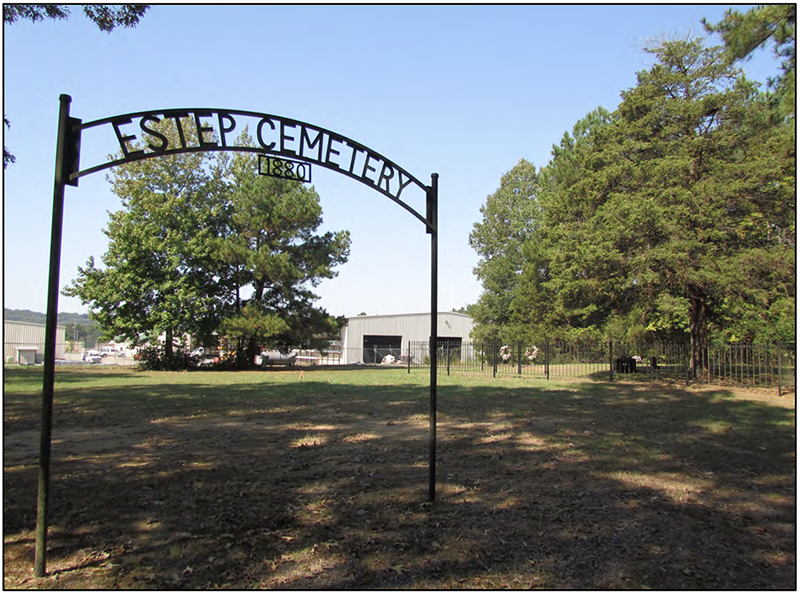
Figure 1. View to the northwest of the large iron sign with the Estep Cemetery located behind. Whit-Davis Lumber Company can be seen in the background in the adjoining property.
| Excel Inventory | Feature Forms | Photographs |
On October 8, 2021, the Jamie C. Brandon Center for Archaeological Research (JCB Center), Faulkner County Museum, and University of Central Arkansas (UCA) students conducted a survey and mapping program at the historic Estep Cemetery (3FA345) located in Greenbrier, Arkansas (Figures 1 and 2). The purpose of the fieldwork was three-fold: (1) survey the cemetery area using electrical resistivity subsurface survey methods to evaluate evidence of possible unmarked burials; (2) map, photograph, and document the visible cemetery stones to compare with previous cemetery documentation efforts (Johnson 2012) and evaluate the presence of damaged or missing stones; (3) utilize low-altitude drone imagery to document the current distribution of the cemetery stones and landscape features. In 2016, Mr. Bill Hinkle, sole surviving Estep family member and caretaker of cemetery, donated cemetery to the City of Greenbrier.
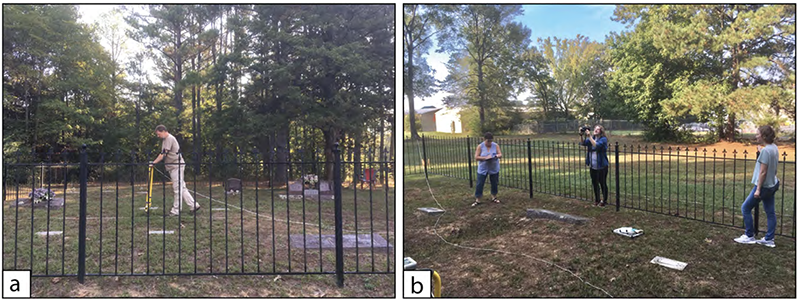
Figure 2. (a) Dr. McKinnon collecting electrical resistivity data within the cemetery boundary area; (b) Lynita Langley-Ware and two UCA students documenting visible stones.
The cemetery is a small inactive family cemetery located a few hundred meters east of Highway 65 within Township 7 North, Range 13 West, Section 21 (Figure 3a). Today, the cemetery is located behind Whit-Davis Lumber Company and can be accessed from Business Park Drive and then north on a small unpaved road. It is currently owned by the city of Greenbrier. The 1980 Faulkner County Historical Society census states, “Samuel W. and Sarah W. Estep bought 80 acres of land and built a small log cabin. After the land was cleared, but before a larger house could be built, Samuel Estep died in 1880 and his widow buried him near a pine tree.” The last burial at the cemetery was Vera (Tapley) Ardis (1909-1988). She is buried with her husband Basil Ardis (1898-1971) — great grandson of Thomas Ardis (1799-1875) who immigrated to the United States from Scotland in the early 19th century (Figure 3b).
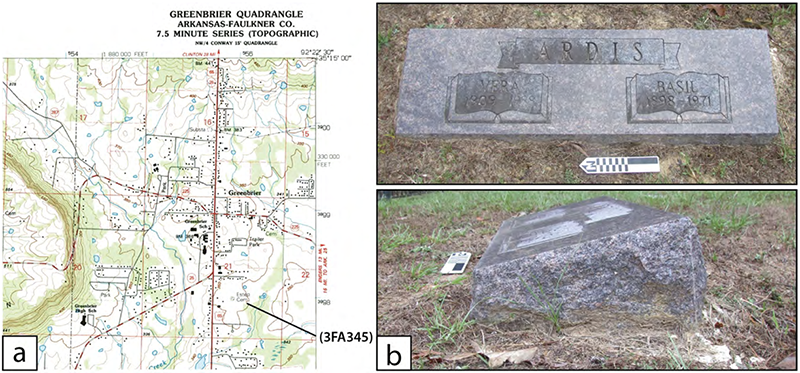
Figure 3. (a) Location of Estep Cemetery using Greenbrier 7.5 minutes quadrangle; (b) Top and side view of the Vera and Basil Ardis marker stone (R1F1).
CEMETERY ORGANIZATION
The Estep Cemetery is organized into several north-south rows of visible surface stone features that mark the burial locations of at least 15 interred individuals (Figure 4a). As part of this survey and mapping project, rows were numerated into four rows beginning in the southwest corner and moving eastward. Visible surface stones located within each row were assigned a feature number beginning in the south and moving north. A total of 18 visible features were recorded during the survey. These include vertical and horizontal (on the ground surface) headstones, and a few small horizontal footstones.
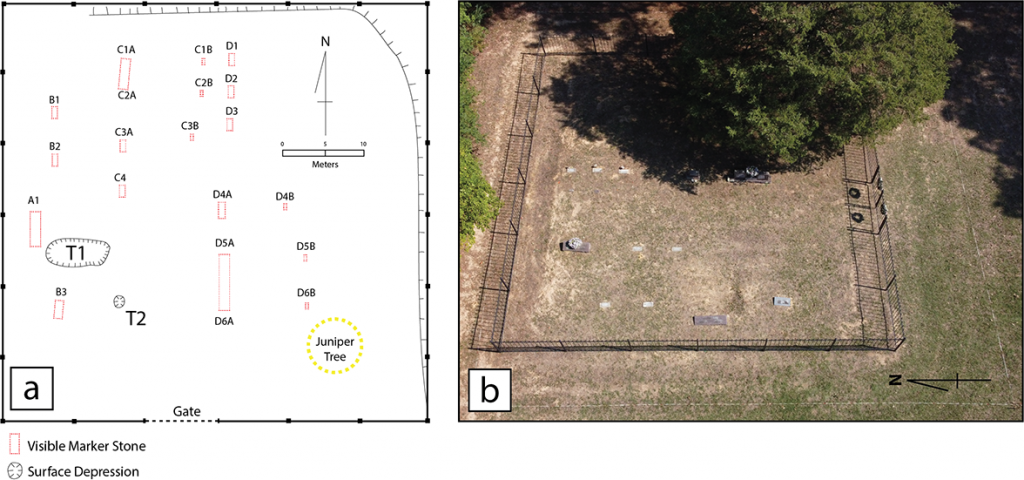
Figure 4. (a) Location of visible cemetery features organized into four rows; (b) Drone image taken oblique and from the west.
The cemetery landscape consists of a small raised area that is fairly level with no vegetation overgrowth. A large iron fence delineates the burial area with an access gate on the south (Figure 4b). The cemetery is regularly maintained by the City of Greenbrier. During the survey, grass had been recently mowed and only minor naturally-occurring debris was visible. A single large overgrown juniper (cedar) tree is located in the southeast corner. The canopy shades close to 25 percent of the cemetery. A small eroded, sloping edge is present in the northeast corner, which is likely the result of rainwater moving and eroding off the raised cemetery. In the northeast corner there are no visible stones, although resistivity data (see below) suggests the possibility of unmarked burials in this location.
Two topographic depressions were also recorded (see Figure 4a). A large topographic depression (T1) represents a sunken area associated with the A2 burial (Basil Ardis). A smaller depression (T2) is aligned with Row 3 burial markers and may represent the former location of a footstone for the B1 burial or a primary headstone marker for an unknown individual. However, resistivity data (see below) does not suggest the presence of an unknown individual in this location.
Of the fifteen documented individuals, there are five infants ranging in age from newborn to 4 years. Two individuals were aged in their 30s. One of these includes Samuel W. Estep, who served in the Confederate 3rd Arkansas Calvary, Company G for Ouachita County. A single individual was in her 50s and six individuals were greater than 70 years in age. The oldest individual recorded is Samuel “Sam” Lorenza, aged 92 years.
Current stone makers are granite, with the exception of those that have been replaced by custom made markers with hand hammered plaques, presumably made and installed by Mr. Bill Hinkle in 2016 when he donated the cemetery to the City of Greenbrier. The plaques are attached to buried 8 x 4 x 16 concrete cinder stones. They represent replacements of sandstones that were not present during the 2003 inventory (Johnson 2012) or have been removed since that time (Figures 5 and 6).
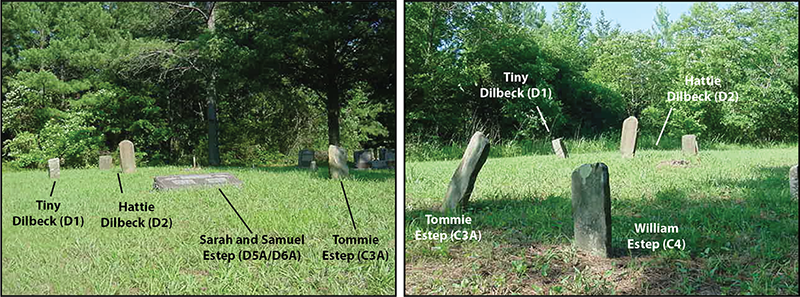
Figure 5. Locations of sandstones replaced with custom concrete markers (Johnson 2012).
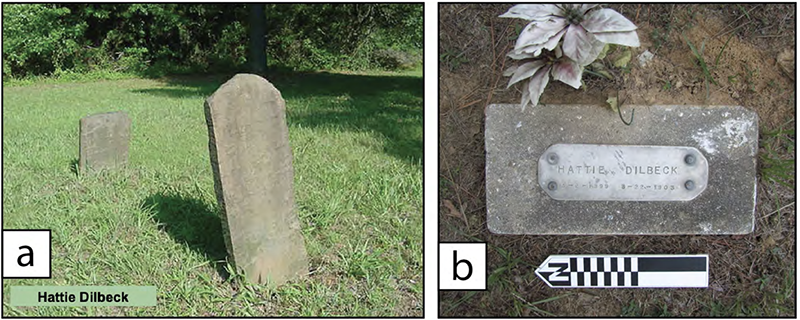
Figure 6. (a) Sandstone headstone and footstone for Hattie Dilbeck as documented in 2003 (Johnson 2012); (b) Custom concrete stone for Hattie Dilbeck that was installed as a replacement.
RESISTIVITY SURVEY
Electrical resistance surveys measure the level of resistance (R) in the subsurface by injecting a current (I) into the ground using a low voltage (V) resistance meter. The ratio of current to voltage defines resistance and is expressed by Ohm’s Law, mathematically stating that R=I/V. While resistance is an electrical quality, resistivity is the actual specific property of the material. Its conversion allows for the “resistance of different materials to be compared in a standardized way” (Clark 1996:27). Electrical resistivity is measured and reported in ohm- meters.
Variations in resistance measurements are based on the principle that geological features hold different materials and different amounts of moisture. Both exhibit varying levels of resistance to an electrical current, and the latter has a particularly large effect in archaeological sites. As a general principle, these varying levels of high resistance (low conductivity) might represent a shallow subsurface of compressed soil matrix, such as a compacted buried surface where porosity is decreased and evaporation is elevated. In contrast, a measurement of low resistance (high conductivity) might represent a pit or depression where moisture has accumulated into a more porous soil matrix and is less likely to evaporate–or at least evaporate at a slower rate.
At Estep Cemetery, a 20 x 20-meter grid was established in order to encompass the fenced cemetery area with small areas outside the delimited space (Figure 7a). Electrical resistivity was collected within the 20×20 meter grid with spacing between transects (Y) and along the baselines (X) each set to half-meter spacing. Current (I) ranges were set to 1 mA at an output voltage (V) of 40 V allowing for a resolution of 0.0005 ohms. Data were collected zigzag (walking back and forth) using an RM Frobisher TAR-3 Resistance meter (Figure 7b).
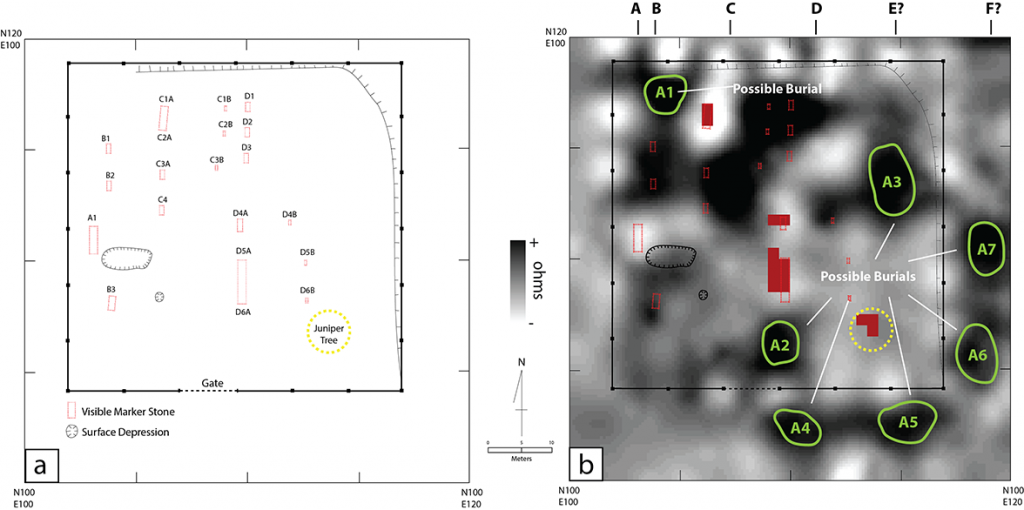
Figure 7. (a) Location of resistivity grid and cemetery features; (b) resistivity results with surface features overlain.
Resistivity survey results reveal several high resistance concentrations that suggest the possible locations of unmarked or undocumented burials within the fenced cemetery area associated with established burial rows (Figure 8). In the northwest corner, is a high resistance anomaly (A1) that is aligned with the Row B burials. The anomaly is directly north of the John Burkett [B2] and Infant Reynolds [B1] markers. A second high resistance anomaly (A2) is located to the south, directly within the current gated entrance. It is aligned with the Row D burials. A third high resistance anomaly (A3) is located in the northeast corner. It does not correspond with a documented burial row or current visible surface stones.
Four high resistance anomalies (A4 – A7) of similar size and shape are documented outside of the fenced cemetery area (Figure 8b). They are located on the south and east portion of the survey area. Their similar size and shape, equally spaced patterning, and proximity to cemetery suggest additional possible burials. For example, A4 is located directly south of A2 and six documented burials (five stones) within Row D. Anomaly A5 is located directly south of A3, which may define a fifth (Row E) burial row. Anomalies A6 and A7 are aligned north south and may represent possible burials which document a sixth (Row F) burial row.
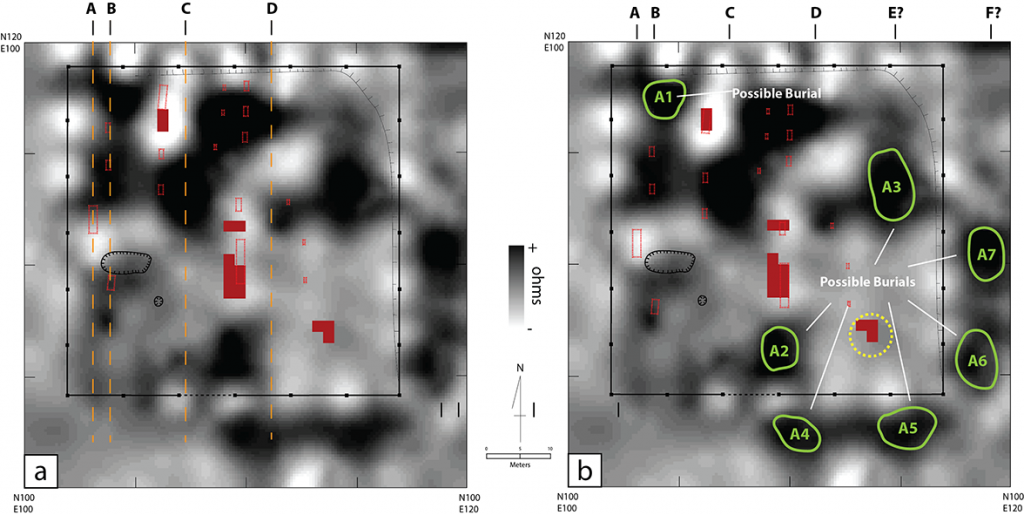
Figure 8. (a) Resistivity results with Row lines overlain; (b) Resistivity results with several high resistance anomalies highlighted.
While the patterning, size, and association to known burial locations and rows suggest high resistivity anomalies could represent undocumented burials, further archival and historical research should be undertaken in order to evaluate if additional individuals are buried at Estep Cemetery.
Data are integrated using ArcGIS 10 and exported to a KMZ file that can be opened using Google Earth or ArcGIS Earth. The KMZ file can be downloaded here.
For more information:
Clark, Anthony
1996 Seeing Beneath the Soil: Prospecting Methods in Archaeology (New Edition). Revised Edition. B. T. Batsford Ltd., London
Johnson, Sondra
2012 Estep Cemetery, Greenbrier, Faulkner County: Census and History. Faulkner County ARGenWeb, https://www.argenweb.net/faulkner/
McKinnon, Duncan P., and Bryan S. Haley (editors)
2017 Archaeological Remote Sensing in North America: Innovative Techniques for Anthropological Applications. University of Alabama Press.
